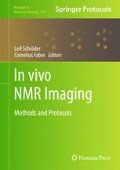Abstract
This chapter provides an overview of how contrast in MR images can be achieved. The physical origin of the most basic contrast mechanisms is briefly explained and experiments to exploit these are discussed. Furthermore, the concept of using exogenous contrast agents is introduced.
Access this chapter
Tax calculation will be finalised at checkout
Purchases are for personal use only
References
Kuo, Y.-T., Herlihy, A. H. (2008) Optimization of MRI contrast for pre-clinical studies at high magnetic field. In Webb, G. A. (ed.), Modern Magnetic Resonance, Vol. I, pp. 759–768. Springer, Dordrecht.
de Graaf, R. A. (2007) In vivo NMR spectroscopy – dynamic aspects, Chapter 3. In de Graaf, R. A. (ed.), In Vivo NMR Spectroscopy, Principles and Techniques. Wiley, West Sussex.
Neuberger, T., Webb, A. (2009) Radiofrequency coils for magnetic resonance microscopy. NMR Biomed. 22, 975–981.
Baltes, C., Radzwill, N., Bosshard, S., Marek, D., Rudin, M. (2009) Micro MRI of the mouse brain using a novel 400 MHz cryogenic quadrature RF probe. NMR Biomed. 22, 834–842.
Callaghan, P. T. (1991) Principles of Nuclear Magnetic Resonance Microscopy. Clarendon Press, Oxford.
Krause, W. (ed.). (2002) Contrast Agents I – Magnetic Resonance Imaging. Springer, Berlin.
Caravan, P. (2006) Strategies for increasing the sensitivity of gadolinium based contrast agents. Chem. Soc. Rev. 35, 512–523.
Ugurbil, K., Adriany, K., Akgün, C., Andersen, P., Chen, W., Garwood, M., Gruetter, R., Henry, P.-G., Marjanska, M., Moeller, S., Van de Moortele, P.-F., Prüssmann, K., Tkac, I., Vaughan, J. T., Wiesinger, F., Yacoub, E., Zhu, X.-H. (2006) High magnetic fields for imaging cerebral morphology, function, and biochemistry. In Robitaille, P.-M., Berliner, L. (eds.), Ultra High Field Magnetic Resonance Imaging, pp. 285–343. Springer, New York, NY.
Lei, H., Zhu, X.-H., Zhang, X.-L., Ugurbil, K., Chen, W. (2003) In vivo 31P magnetic resonance spectroscopy of human brain at 7 T: an initial experience Magn. Reson. Med. 49, 199.
Reiser, M. F., Semmler, W., Hricak, H. (eds.). (2008) Magnetic Resonance Tomography. Springer, Berlin.
Huppertz, A., Zech, C. J. (2008) Contrast agents. In Reiser, M. F., Semmler, W., Hricak, H. (eds.), Magnetic Resonance Tomography, pp. 92–113. Springer, Berlin.
Burtea, C., Laurent, S., Van der Elst, L., Muller, R. N. (2008) Contrast agents: Magnetic resonance. In Semmler, W., Schwaiger, M. (eds.), Molecular Imaging I, Handbook of Experimental Pharmacology 185/I, pp. 135–165. Springer, Berlin.
Tóth, E., Helm, L., Merbach, A. E. (2002) Relaxivity of MRI contrast agents. In Krause, W. (ed.), Contrast Agents I – Magnetic Resonance Imaging, pp. 61–101. Springer, Berlin.
Corot, C., Port, M., Guilbert, I., Robert, P., Raynal, I., Robic, C., Raynaud, J.-S., Prigent, P., Dencausse, A., Idée, J.-M. (2007) Superparamagnetic contrast agents. In Modo, M. M. J., Bulte, J. W. M. (eds.), Molecular and Cellular MR Imaging, pp. 59–83. CRC Press, Taylor & Francis Group, Boca Raton.
Weissleder, R., Moore, R., Mahmood, U., Bhorade, R., Benveniste, H., Chiocca, E. A., Basilion, J. P. (2000) In vivo magnetic resonance imaging of transgene expression. Nat. Med. 6, 351.
Bergin, C. J., Pauly, J. M., Macovski, A. (1991) Lung parenchyma: projection, reconstruction MR imaging. Radiology 179, 777–781.
Author information
Authors and Affiliations
Corresponding author
Editor information
Editors and Affiliations
Rights and permissions
Copyright information
© 2011 Springer Science+Business Media, LLC
About this protocol
Cite this protocol
Schröder, L., Faber, C. (2011). Basic Contrast Mechanisms. In: Schröder, L., Faber, C. (eds) In vivo NMR Imaging. Methods in Molecular Biology, vol 771. Humana Press. https://doi.org/10.1007/978-1-61779-219-9_3
Download citation
DOI: https://doi.org/10.1007/978-1-61779-219-9_3
Published:
Publisher Name: Humana Press
Print ISBN: 978-1-61779-218-2
Online ISBN: 978-1-61779-219-9
eBook Packages: Springer Protocols

